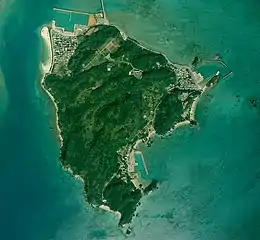Hamahiga Island
Hamahiga Island (浜比嘉島, Japanese: Hamahiga-jima, Okinawan: Bamahija-shima) is an island located in the Yokatsu Islands of Okinawa Prefecture, Japan.[1][2] Its administered by the city of Uruma and is located near the Katsuren Peninsula.
| 浜比嘉島 | |
|---|---|
 | |
| Geography | |
| Coordinates | 26°19′14″N 127°57′30″E |
| Archipelago | Ryukyu Islands |
| Administration | |
| Okinawa Prefecture | |
| Uruma City | |
| Demographics | |
| Population | 600 |
| Ethnic groups | Ryukyuan, Japanese |
Hamahiga has a total population of 600 people.[3] There are two villages on the island, Hama (浜) to the north and Higa (比嘉) to the south.[1]
History
During the Sanzan period, Hamahiga and the rest of the Yokatsu Islands were under the control of Chūzan. By the 15th century, Chūzan had united the Okinawa Islands, forming the Ryukyu Kingdom.[4]
In 1879, Japan annexed the Ryukyu Kingdom, turning it into Okinawa Prefecture. Hamahiga was a part of this prefecture until the end of World War II, when Okinawa in its entirety were placed under the United States Civil Administration of the Ryukyu Islands from 1950 to 1972.[5] After the Okinawa Reversion Agreement, Hamahiga was once again placed under the administration of Japan.
Culture
Hamahiga Island is notable for its preservation of Okinawan culture.[2] This can be seen in the widespread usage of both traditional cuisine and architecture.[2]
In the Ryukyuan religion, it's believed that the creation goddess, Amamikyu, and her partner, Shinerikyu, lived in a cave in southern Hamahiga after creating the Okinawa Islands.[2][3] Amamikyu's tomb is also said to be in Hamahiga.[6]
References
- "Hamahiga Island". VISIT OKINAWA JAPAN. Retrieved 2020-09-28.
- "Hamahiga Island: Traditional Okinawan Culture and Peaceful Village Life". skyticket Travel Guide. Retrieved 2020-09-28.
- "This Weeks News - JapanUpdate.com". www.japanupdate.com. Retrieved 2020-09-28.
- "Okinawa's History INDEX". rca.open.ed.jp. Retrieved 2020-09-28.
- Fisch, Arnold (1987). "Military Government in the Ryukyu Islands 1945-1950" (PDF). U.S. Army Center of Military History.
- "近所の琉球歴史". www.nifee.net (in Japanese). Retrieved 2020-09-28.